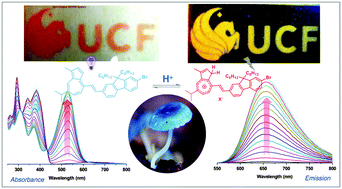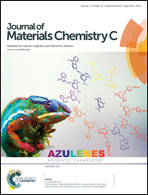Chromophoric materials derived from a natural azulene: syntheses, halochromism and one-photon and two-photon microlithography†
Abstract
In addition to their use as colorants in food and cosmetics, various natural dyes possess photophysical properties that could enable their use as modular building blocks for preparing eco-friendly and non-toxic chromophores. Among the natural pigments, guaiazulene holds great potential due to its unique optical and electronic properties. Thus, in order to explore and understand the properties of guaiazulene-containing chromophores, a series of 4-styrylguaiazulenes 3a–l were prepared by condensation of the C-4 methyl group of naturally-occurring guaiazulene 1 with various aromatic carboxaldehydes 2a–l. Treatment of these analogs 3a–l with a strong acid protonates the electron-rich C-3 position and reveals a reversible halochromic behavior where the optical energy gap responds predictably to the electron-donor strength and the degree of π-conjugation. Additionally, acid-doping is accompanied by efficient fluorescence switch-on, where 3e(H+) and 3g(H+) exhibited considerably higher fluorescence quantum yields than the neutral precursor. These properties facilitated the design of a new non-erasable 3D fluorescence readout (permanent or write-once read-many, WORM) system, which is comprised of a switch-on fluorescent guaiazulene-containing chromophore 3e and a commercially available iodonium photo-acid generator (PAG) in thin polymethyl methacrylate (PMMA) films.


 Please wait while we load your content...
Please wait while we load your content...